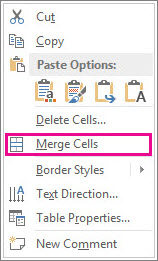

To change the style settings go to the style gallery at Home | Style | Cell Styles, right-click on the style to see other options, including Modify …. when I merge cells, my merged rows over cells as in the screenshot 'before'. Click on Format … to change any formatting.For example, you might de-select ‘Border’ and ‘Protection’ since they are often applied more broadly. Select the table, the go to the Design tab, click Convert to Range, and then click Yes in the popping dialog to convert the table to a range which also looks like a table. UNcheck any formatting type you don’t want the style to apply. In Excel, there is no way that can merge cells in a table, but here I introduce a roundabout trick for you to merge cells in a table.Change the name to something more useful.As you can see, all the formatting from the selected cell has been copied into the new style.

A style dialog will open with all the cell formatting copied into it.Go to Home | Style | Cell Styles | New Style.Format a cell the way you want it to look including content formatting, color, border etc.To make a new style, start with an example cell that has, or is close to, the formatting you want: What you create in an Excel style is what you get. In fact it’s more straight-forward than in Word because you don’t have to worry about inheritance from another style. The only way you can apply all the formatting to the bottom right cell is to make a new style. You can’t have a ‘base’ style then apply another style over it, even if the two styles complement each other. The link to ‘40% Accent 2’ was broken.Įxcel styles are not linked or inherited as in Word. When the ‘Currency’ style was applied, Excel copied the existing fill formatting into fixed (non-style) formatting then applied the new style.

Why not? The bottom cell has the ‘40% Accent 2’ style just like the cell above it, so why does it still have the old color.Įxcel can only apply a single style to a cell, even if the styles affect different attributes of the cell.


 0 kommentar(er)
0 kommentar(er)
